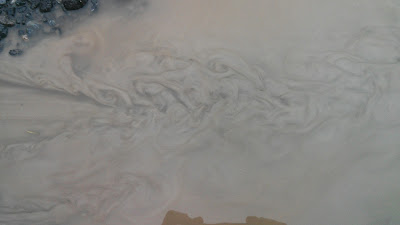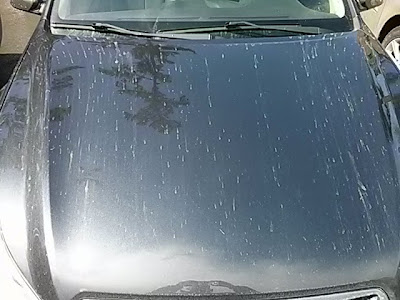
Fluid Visualization in Nature
On the rare occasions that CFD-ers unhitch from their Matrix and venture outdoors, it is only to see that nature is copying the visualization techniques we take for granted in Computational Fluid Dynamics (CFD).
 Flowing Stream Visualization Via Silt
Flowing Stream Visualization Via Silt
Streaklines
Though in CFD we tend to concentrate on streamlines (the instantaneous path tangential to the velocity field), nature prefers streaklines. Streaklines provide a richer insight into the time history of an injected tracer. Tracers can take many forms, e.g., pollen and silt.
 Pollen Streaklines on a Puddle
Pollen Streaklines on a Puddle
Iso-Surfaces
Nature provides an excellent example of an iso-surface visualization when a plume of saturated steam is ejected from a chimney. The surface of the plume marks the outer boundary of the saturated steam that has condensed after coming into contact with the cold air surrounding it.
Saturated Steam Ejected from a Chimney Forming an Iso-Surface
Contours
Surface contours are analogous to volume iso-surfaces. A good example is oil floating on flowing water, which produces surface colored contours. The oil layer becomes thinner in the presence of faster moving flow regions and this varies the polarizing effect of light reflected off the oily surface, leading to a spectrum of colors.
Oil Contours on a Stream
Vectors
Visualizing vectors in CFD as arrows or lines is a common practice, and no less so in nature too. Nature can produce velocity-aligned vectors as streaks on a car hood. All you need is to drive through a rain storm on a hot day which coincides with tree pollen season, then wait for the rain to stop and the pollen streaks to dry.
 Pollen Streaks on a Car Hood
Pollen Streaks on a Car Hood
Recent blog posts
- CFD Simulates Distant Past
- Background on the Caedium v6.0 Release
- Long-Necked Dinosaurs Succumb To CFD
- CFD Provides Insight Into Mystery Fossils
- Wind Turbine Design According to Insects
- Runners Discover Drafting
- Wind Tunnel and CFD Reveal Best Cycling Tuck
- Active Aerodynamics on the Lamborghini Huracán Performante
- Fluidic Logic
- Stonehenge Vortex Revealed as April Fools' Day Distortion Field
